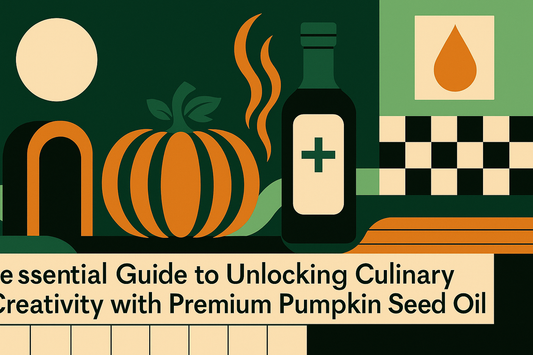
Toasted vs. Cold-Pressed: Choosing the Right Pumpkin Seed Oil for Your Kitchen
Introduction
Pumpkin seed oil has steadily become a cherished addition to kitchens around the world, celebrated for its rich flavor and notable heritage. In the realm of pumpkin seed oil production, the method used can greatly influence its taste, aroma, and nutritional profile. Two prominent techniques stand out: the toasted method and the cold-pressed method. While both processes yield high-quality oil, each offers distinct characteristics that cater to different culinary needs and preferences. This discussion navigates the nuances of these production methods while also touching on a product that embodies a respected tradition in pumpkin seed oil production.
Overview of Toasted Pumpkin Seed Oil
The process behind toasted pumpkin seed oil begins with a gentle roasting of the seeds. This careful heating not only unlocks a deeper, nutty flavor but also helps in preserving important nutrients such as vitamin E, zinc, and magnesium. The history of this method is steeped in tradition, particularly within the agricultural landscapes of Slovenia, where methods passed down through generations enhance the oil's distinct profile. A fine example in this category is Belvoro Pumpkin Seed Oil, which echoes the heritage and quality of roasted pumpkin seed oil through its unique production process.
Overview of Cold-Pressed Pumpkin Seed Oil
Cold-pressed pumpkin seed oil is produced by extracting the oil from seeds without the addition of heat. This process aims to maintain the original characteristics of the seed by avoiding temperature-induced changes. The result is an oil with a subtler flavor and a milder aroma. While this method helps to keep the seed's natural essence intact, it tends to produce a lighter sensory experience compared to the toasted alternative. Both methods have their own merits, and the choice often depends on the desired taste and intended culinary use of the oil.
Key Comparison Points
Flavor and Aroma
When it comes to flavor, toasted pumpkin seed oil stands apart with its bold, nutty taste and warm aroma. The roasting process intensifies these attributes and imbues the oil with a richer complexity that can enhance dishes ranging from roasted vegetables to hearty salads. In contrast, cold-pressed pumpkin seed oil typically offers a more understated flavor, making it an excellent choice for recipes that require a delicate finishing touch without overwhelming other ingredients. This difference between toasted and cold-pressed pumpkin seed oil is at the heart of many kitchen decisions.
Nutritional Profile
Both production methods deliver an oil rich in valuable nutrients. The heating involved in toasting can aid in the retention of certain micronutrients while adding character to the flavor, making toasted pumpkin seed oil a favorite for those looking for both a nutritional boost and culinary depth. Meanwhile, the cold-pressed process, by avoiding heat, aims to preserve a slightly different composition of natural bioactives. Ultimately, whether you lean toward the richer profile of the toasted version or the more subtle extraction of the cold-pressed method will depend on your personal culinary goals.
Production Process and Sustainability
The methods employed in pumpkin seed oil processing are distinct and each brings its own perspective on tradition and modernity. The toasted approach involves a method refined over generations, often highlighted by its regional roots and artisanal charm. On the other hand, cold-pressed techniques are considered modern in their approach, focusing on maintaining the seed's inherent qualities by eliminating heat. When assessing the environmental and practical aspects of each method, one may find satisfaction in the shared commitment to quality and sustainability, even though the production routes differ.
Culinary Applications
The choice between the two types of pumpkin seed oil naturally extends to their culinary uses. Toasted pumpkin seed oil, with its robust flavor and deep aroma, works wonderfully as a finishing touch on hearty dishes, imparting an unmistakable richness and enhancing the overall dining experience. Cold-pressed pumpkin seed oil, by virtue of its milder character, is well-suited for recipes where subtlety is key, such as delicate dressings or light drizzles on salads. Chefs and home cooks alike benefit from understanding this pumpkin seed oil production methods comparison when selecting an oil that meets the needs of their recipes.
Decision Guidance: Which Method Suits Your Needs?
Deciding between a toasted and a cold-pressed pumpkin seed oil often depends on what you seek in both taste and function. For those who favor a bold and enriched flavor profile that can transform even simple ingredients into an elevated dish, the toasted pumpkin seed oil is an appealing choice. Its deep, nutty profile and aromatic complexity have made it a hallmark in kitchens that celebrate traditional methods. Belvoro Pumpkin Seed Oil, for example, encapsulates these traits with its distinguished production rooted in a Slovenian Styrian background.
If a more delicate flavor is desired—one that offers a subtle enhancement without overt presence—the cold-pressed version may align better with your culinary style. This method provides a softer, more restrained oil that lends itself well to recipes where a nuanced accent is preferred. In making your choice, consider the nature of the dishes you prepare and the type of flavor enhancement you are looking to achieve. Both methods supply valuable nutrients and unique sensory experiences, leaving the decision to your personal taste preferences and cooking practices.
Conclusion
The exploration of toasted versus cold-pressed pumpkin seed oil reveals clear contrasts in flavor intensity, nutritional composition, and culinary application. Toasted pumpkin seed oil offers a robust, enriched experience that is steeped in tradition, while cold-pressed pumpkin seed oil provides a milder, more subtle alternative. Whether you opt for the bold characteristics found in products like Belvoro Pumpkin Seed Oil or choose the lighter touch of cold pressing, understanding these differences equips you to make a more informed choice for your table. Ultimately, the selection rests on the balance of taste, texture, and the unique culinary touch you wish to bring to your dishes.
FAQs
Q: What is the main difference between toasted and cold-pressed pumpkin seed oil?
A: Toasted pumpkin seed oil is produced by gently roasting the seeds, which develops a rich, nutty flavor and may help in preserving nutrients. On the other hand, cold-pressed pumpkin seed oil is extracted without the application of heat, often leading to a milder taste profile.
Q: How does the toasting process affect the oil’s flavor and aroma?
A: The gentle roasting not only boosts the natural aroma but also creates a deeper and more pronounced flavor. This process enhances the oil's sensory characteristics, setting it apart from the subtler profile of cold-pressed oil.
Q: Are there notable differences in nutritional benefits between the two methods?
A: Both production methods yield a product rich in valuable nutrients. The toasting process may preserve certain nutrients while also adding distinctive sensory characteristics, but the preference ultimately depends on individual needs and culinary applications.



